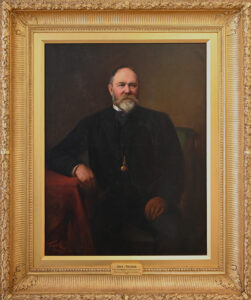 Parliamentarian, grazier, and philanthropist, John Riddoch (1827-1901) was committed to the growth of his new home in the southeast of South Australia. Originally from Scotland, and finding wealth in the goldfields of Victoria, Riddoch used his gold funds to start up in Geelong as a storekeeper and wine merchant. Seeking new challenges, he purchased land at Yallum Park near Penola, South Australia in 1861. He became an experimental farmer who continued to grow his land holdings, successfully running sheep. Riddoch also recognised the riches of the terra rossa soil in the region, founding the Coonawarra Fruit Colony in 1891 in what would kick start a flourishing wine-producing region.
Parliamentarian, grazier, and philanthropist, John Riddoch (1827-1901) was committed to the growth of his new home in the southeast of South Australia. Originally from Scotland, and finding wealth in the goldfields of Victoria, Riddoch used his gold funds to start up in Geelong as a storekeeper and wine merchant. Seeking new challenges, he purchased land at Yallum Park near Penola, South Australia in 1861. He became an experimental farmer who continued to grow his land holdings, successfully running sheep. Riddoch also recognised the riches of the terra rossa soil in the region, founding the Coonawarra Fruit Colony in 1891 in what would kick start a flourishing wine-producing region.
Always seeking opportunities for his new home, Riddoch was elected to the House of Assembly as the representative for the district of Victoria from 1865-70 and then from 1871-73. He became the inaugural chairman of the Penola District Council in 1869 and held that position for 25 years. Riddoch used his position within parliament to agitate for development in the region, notably a train line between Mount Gambier and Naracoorte. In 1885, Riddoch obtained a grant of £1000 to build an extension to the Mount Gambier Institute, which the state government then matched.
A testament to his popularity, a portrait by British society painter Tennyson Cole was paid for through public subscription during an economic depression. The portrait was presented to Mount Gambier Institute on 21 November 1891 and upon acknowledgment of this fine painting, Riddoch modestly said:
“In a gallery like this it seems to me that some thing more is looked for than the portraits of grizzly old men, and I would hope soon to see pictures of a more interesting and attractive nature adorning its walls.” ¹
Riddoch, it seems, was something of an orator and possessed an aptitude for hitting the public nerve in just the right spot with a combination of ambition, humor and humility – words he backed up with action. Entrepreneurial in business, Riddoch was also socially oriented, and his philanthropic pursuits have had a lasting impression on Mount Gambier and surrounds, notably the naming of this arts centre.
Image: Tennyson Cole, John Riddoch, 1891, oil on canvas. Collection of The Riddoch Arts & Cultural Centre.
¹ No author, ‘Presentation to the Institute’ in Border Watch, 21 November 1891 p 2.



